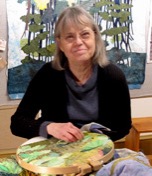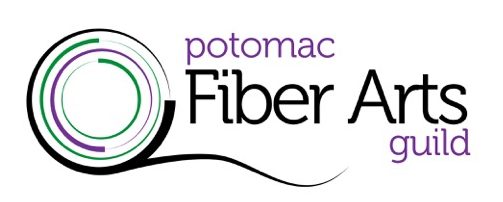November 12, 2022
Program and Workshops
Carol Anne Grotrian
The Artist:
Carol Anne Grotrian began quilting in the early 1980s, and soon discovered shibori, Japan’s ancient tradition of tie-dye. Shibori helped her find her voice in landscape quilts. She dyes the fabric for her quilts using fiber-reactive dyes and indigo. In recent years, she added the slow stitch techniques of raw edge appliqué and Japanese boro to her beloved hand quilting. Sharing all these traditions by teaching is, for her, important.
Though the subtext is always ecological, Carol Anne’s landscapes usually express a quiet sense of place, often places she has experienced. They are “breathing spaces” that stop time– seasons, tides or day to night.
Haiku have inspired recent landscapes. These compact Japanese poems usually refer to a season and to commonplace nature. Though she continues to create larger quilts, especially commissions, haiku have led her to smaller, more intimate works. Experiencing a moment of simple beauty in poetry or landscape is a welcome antidote to today’s divisive tensions.
Carol Anne’s sense of place emerged in New England, where she has lived since 1979. Her quilts are in corporate, private and museum collections. They have been exhibited nationally and internationally and appeared in various publications.
Her best critics are her husband of 54 years and her crit group of over 34 years. Her studio is in her home in Cambridge. Her quilts can be seen at www.carolannegrotrian.com

Guild Meeting/Program: Shibori & Me: From Ancient Techniques to Contemporary Quilts
Shibori is an ancient Japanese tradition, an ancestor to tie-dye. Beginning with a demonstration of basic techniques–knotting, binding, pleating, stitching and clamping–digital images briefly trace shibori’s development through historical and contemporary kimonos. I then follow my evolution, describing how this dye technique helped me find my voice in landscape imagery.
Date/Time: November 12, 2022 10:30 AM (following Guild meeting)
Location: St. James Episcopal Church, 11815 Seven Locks Rd, Potomac, MD 20854

Mini Workshop: Orizomegami: The Art of Dyeing Folded Paper
Take the familiar term “origami” that is the Japanese tradition of paper folding, and insert their word for dyeing, “zome,” and you get “orizomegami”, the colorful art of dyeing folded paper. The folds are easy, and patterns come from dipping paper in non-toxic watercolors. The techniques are similar to those used on fabric (itajime), but instead of clamps, orizomegami simply uses finger pressure to control the patterns. We’ll dye tissue paper, useable for gift wrapping, and heavier rice paper suitable for cards, etc.
Date/Time: November 12, 2022 1:00 to 4:00 PM
Location: St. James Episcopal Church, 11815 Seven Locks Rd, Potomac, MD 20854
Mini Workshop Fee: Members: $35.00 Non-Members: $50.00
Student’s Materials Fee: $5
For liquid water colors, rice paper, etc. Materials fees can be paid directly through Paypal. The account is attached to Carol Anne’s email address (carolannegrotrian@gmail.com) or her phone (857-253-1904), Cash or a check works as well.
Student Supply List:
A pack of white tissue paper; additional colored or patterned tissue paper are optional; a pencil and ruler; lightweight “surgical” gloves (best) or standard rubber gloves; a roll of paper towels; a small garbage bag
Click here to print supply list.

Extended Workshop: Fabric Stamping
Add pizzazz to the textiles in your life. Print your own unique patterns with stamps that are fashioned from everyday objects, quickly carved from erasers or simply constructed with glue. The materials are inexpensive and non-toxic, basic techniques are easily learned and the results are immediate. Design theory is introduced as students create their own styles from elegant restraint to outrageous and funky.
Date/Time: Friday, November 11, 2022 10:00 AM to 4:00 PM
Location: PFAG member home in Potomac, MD
Workshop Fee: Members: $80.00 Non-Members: $110.00
Student’s Materials Fee: $5
Carol Anne will bring inks, materials to make stamp pads, and supplies for experimenting with other types of stamps. Materials fees can be paid directly through Paypal. The account is attached to Carol Anne’s email address (carolannegrotrian@gmail.com) or her phone (857-253-1904), Cash or a check works as well.
Student Supply List:
Fabric: pre-washed & ironed and cut into 8” squares: about 20 squares plain muslin and/or light colored prints or light colored solid cottons (more for experimenting optional) and a few squares of dark solids or dark prints; Other Materials 2 white plastic erasers (Magic Rub, Mars Staedler); Exacto knife with sharp blade (not a utility knife); soft leaded pencil with fresh eraser; newsprint pad, 9” x 12” (okay but not necessary; inexpensive from art store, Michaels, etc.) or a couple of magazines and some sheets of typing paper; cheap watercolor brush; foam brushes (one about 1” wide, extras and other widths if you wish); Q-tips (a couple dozen or so); a push pin; scissors (not your best); ruler (6” preferred, C-thru rulers are great); rubber gloves (light weight surgical disposables best); large plastic trash bag (to protect table); roll of paper towels; straight pins or t-pins (a couple dozen); small bottle of white glue (for fabric is best, but any will do); “found objects” to use as stamps–use your imagination (a key, spool, fork, shell, a veggie, a piece of bubble wrap, circular shapes, etc.); a leaf or two (fresh, not dried, indoor or outdoor, look for shape and texture—e.g., fern, maple).
Note: Wear old clothes. Contact Carol Anne if you have questions (carolannegrotrian@gmail.com). Check teaching sections of her website for more information and examples of student work: www.carolannegrotrian.com.
Click here to print supply list

Extended Workshop: An Introduction to Indigo Shibori
Why does indigo seem magical? Because it dates back to ancient Egypt? Because its blue only develops on contact with air? Because successive dipping makes the blue seem like many colors? It’s definitely magical because it’s the perfect partner to shibori.
Shibori, an ancient Japanese art, goes far beyond the usual tie-dye techniques. Try your hand at the elegant patterns found in imperial kimonos. Included are basic techniques– binding, pleating, knotting, stitching, clamping and pole-wrapping—that are easy to learn and endlessly variable.
Experience the magic and learn about the care and feeding of an indigo vat, using synthetic indigo. We’ll use the vat to create samples of shibori patterns on cotton cloth, with the potential for creating your own sampler quilt. Experimenting on silk is optional.
This workshop will focus on indigo dyeing. We’ll prepare fabric in shibori patterns from various world traditions, which we’ll dye in smaller vats that are more practical for most people’s time and space. Synthetic indigo mimics the original plant source and assures results. If you’ve taken a shibori workshop, you can prepare some shibori for class. Due to smaller dye pots, limit samples to about 12” squares or 9”x12” fat quarters. If you haven’t worked previously with shibori, I’ll be teaching the basics.
Date/Time: November 13 – 14, 2022 10:00 to 4:00 PM
Location: PFAG member home in Potomac, MD
Workshop Fee: Members: $160.00 Non-Members: $220.00
Student’s Materials Fee: $5
Materials fee includes the ingredients for the dye vats as well as vinegar, soap, clean up supplies, handouts and dye recipes. Materials fees can be paid directly through Paypal. The account is attached to Carol Anne’s email address (carolannegrotrian@gmail.com) or her phone (857-253-1904), Cash or a check works as well.
Student Supply List:
Fabric: 2-3 yds of washed, dried, untreated, 44-45 “ wide 100% white cotton, cut in the following manner: (1) cut 9” (1/4 yard) strips across the fabric’s width (you’ll get 5 for sure, the 6th may be a bit smaller if prewashing shrank the yardage); (2) cut 2 of these strips into 9” squares = 8 – 9”squares + 2 smaller leftovers; (3) cut 3 of these strips in half = 6 – 9” x 22” rectangles; (4) bring the leftovers to class for experimenting. Additional cotton, linen or silk: small amount for experimenting (optional). Note: PFD or “prepared for dyeing” fabric is not required but guarantees the best results. Other Materials: Thread: button & carpet, craft or upholstery thread (stronger than for regular sewing); sewing needles (large enough for above thread); thimble if you use one; twine (e.g. kite string) or medium- to heavy-weight crochet thread; waxed dental floss, any flavor; embroidery-sized scissors with pointed blades (not your best) or thread snips; seam ripper (optional); pencil; 12-inch ruler; masking tape; a few rubber bands (especially very small ones) (optional); a few pebbles, beans or marbles; clothespins (12 or more), plastic or wooden, the ones with moving parts) and/or large paper clips; a couple of wine corks or pink pearl erasers; small spray bottle; a 1-quart plastic container (e.g. yogurt); a small bucket (1-2 gal.); box of gallon baggies (to take home damp dyed fabric); a lidded container (milk jug, quart jars, etc.) to possibly take some indigo home (optional); a trash bag; a roll of paper towels; an old towel; rubber gloves (à la Playtex); surgical weight rubber gloves (optional). Optional: PVC pipe, 24 inches long, 1 1/2 to 2 inches in diameter. If leftover from plumbing project, outside surface needs to be smooth and non perforated.
Wear old clothes.
Bring any shibori or tie dye samples you may have, and a sample of your work if you wish.
Note: If you have any questions, contact Carol Anne at 857-253-1904 or carolannegrotrian@gmail.com. Also see www.carolannegrotrian.com.
Click here to print supply list
